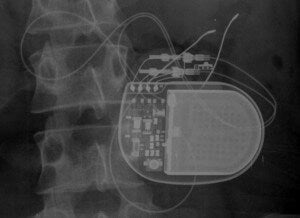Modern medicine may not have reached the level of the Bionic Woman, but intestinal implants are turning more and more diabetics into low-grade cyborgs. The device in question is Enterra ®, a neurostimulator from Medtronic, that treats gastroparesis. This stomach disorder effects up to 1 in 5 diabetics and basically prevents food from progressing through the GI tract. Non-diabetics can develop the disorder from surgery, medicine reactions, or auto-immune diseases. With the implant, however, most patients can hope to reduce many of gastroparesis’ nastier symptoms like bloating, nausea, and vomiting.

It takes general anesthesia and surgery to place the Enterra ® device, but afterwards doctors can adjust it externally, using a remote apparatus. Not a bad trick, and one that allows patients to avoid further invasive procedures. While it may take a little more work to install than other implants (did you know that a pacemaker only requires local anesthesia nowadays?) it has benefited from their popularity. Medtronic received special humanitarian device exemption (HDE) from the US FDA for Enterra ®. This means that while the device’s benefits haven’t been proven rigorously, the FDA is willing to let it be placed in patients. All it takes is a facility’s institutional review board to approve the device, and many have already done so.
That’s a big leap in faith for government and patient alike, and it says something about our modern opinion of implants. We’ll take any solution that’s likely to work, and especially if it seems high tech enough. Singularity Hub recently discussed stem cell treatments for diabetes, but the truth is that most of the people suffering from diabetes and related disorders need treatments that are available today. For some of those, implants are a solution, and are well worth any associated risks.

Like most other implants, Enterra® is a neurostimulator, working to replace or compensate for our most finicky of cells: nerves. As technology progresses, however, implants will likely evolve from purely electrical devices to chemical synthesizers. With the advance in technology, you can bet patients will be clambering to try them out. Why not? — we all want to upgrade.
Everywhere we look, cybernetics is working its way into our lives and under our skin. The Enterra® implant is only one of the many possible paths to introducing cyborgs into our lives. Singularity Hub has shown you the telescopic eye, continuous body sensors, external robotic skeletons, and brain-controlled arms and wheelchairs — all possible routes to melding man and machine. While some of these technologies hope to improve individuals beyond human limits, most will also be used to level the playing field for humans with disabilities. In either case, cybernetics may one day develop into the cure for the common human.
While few currently used implants are considered “cures”, most have proven to be invaluable as treatments. Hopefully Enterra ® will join the pacemaker as a safe and functional solution to a common disorder. When it comes to sufferers of gastroparesis, we can rebuild them…better, stronger, faster…or at least with the ability to pass food through their stomachs.


